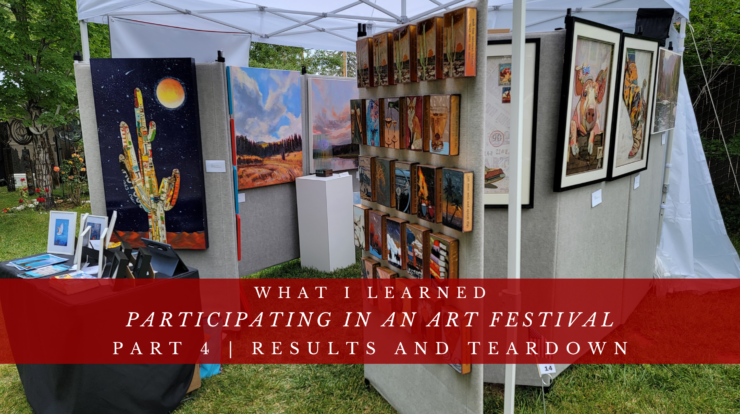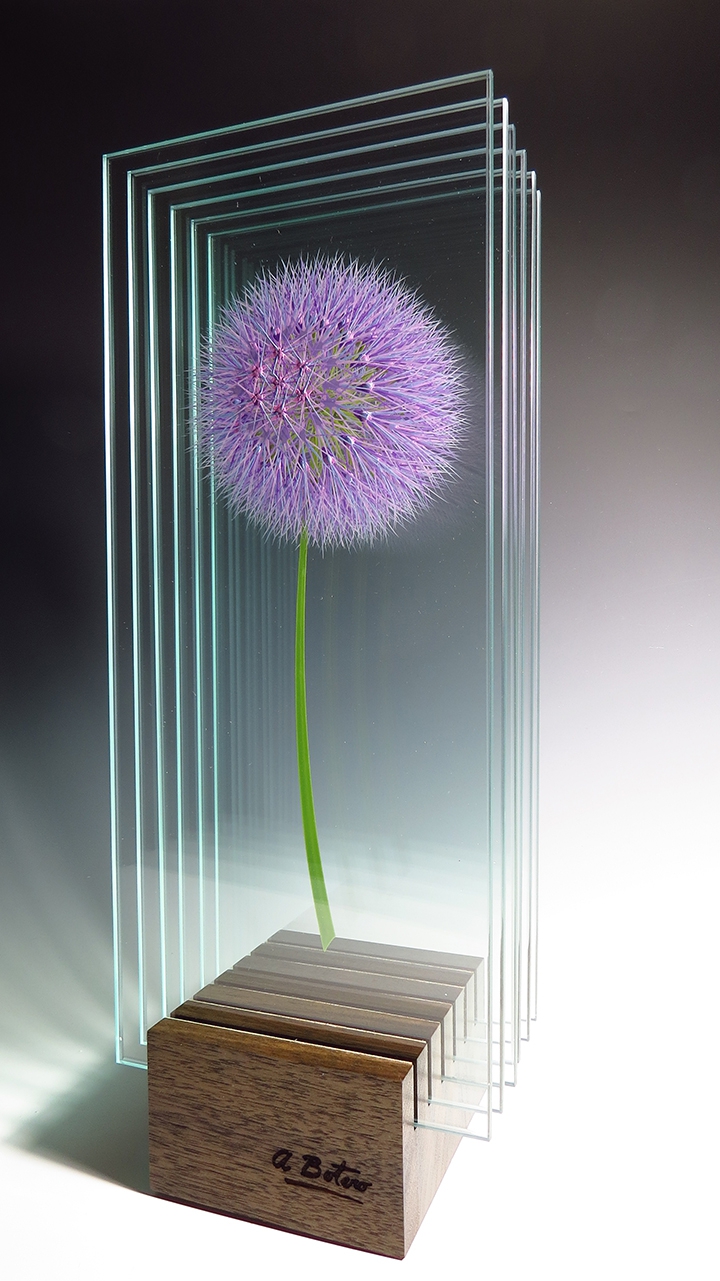
Over the last week, I’ve shared my experience preparing for, setting up, and participating in an outdoor festival in Pinetop, AZ, where we have our second gallery. Overall, it was an exciting, grueling, engaging, mystifying process. All that remains is to examine the show’s results, the teardown, and lessons learned (in addition to lessons already mentioned in my other posts).
Sales
Let’s get right to the most important result, sales. At the end of the day, other benefits came from participating in the show, but the sales were the goal. So how did we do?
I wasn’t sure what to expect from the event. Would we generate hundreds of dollars in sales? Thousands? Tens of thousands? I had no idea. I understood that we would have thousands of people seeing our booth and art, and one can’t help but dream of a big payday. Having thousands of people through would significantly increase exposure, as, during a typical summer in Pinetop, we might only have a thousand people through the gallery all summer.
In the end, raw visitor count doesn’t correlate to conversion. It turns out that our conversion rate (ratio of visitors to sales) is way better in the gallery. This makes sense, as visitors to the gallery are self-selecting an interest in art. The festival attracted many prospective art buyers, but it also attracted visitors simply looking for a pleasant summer activity. The exciting challenge at the show was seeing which visitors were buyers and which were enjoyers (spoiler: it’s tough to tell by appearance).
As mentioned in my previous post on our experience at the event, we quickly discovered that sales didn’t start early in the day. Visitors would wander into the festival and explore for a while before making decisions. Once sales kicked in, two to three hours after the event’s start, they were pretty steady, though small. Our first sale was for a $165 item, and subsequent sales through the first day were likewise for $20-$200, though some buyers bought multiple items. Total sales for the day were around $1000.
Okay, $1000. If the pace of sales continued through the rest of the three-day event, we could anticipate about $3,000 in sales total. Not great, we wouldn’t make back the initial investment we made to prepare for the show, but we would break even and make a little in terms of operating expenses.
Day two, Saturday, ended up creating a similar dynamic. A few hours before, we saw our first sale, but then steady sales throughout the afternoon (at least when it wasn’t raining). On Saturday, however, we had several sales in the $200-$500 range, and we didn’t have as much rain as we had on Friday. By the end of the day, total sales were just above $3000 for the day. That’s more like it!
After accounting for artist commissions, we have now at least nearly recovered the cost of our ProPanels, canopy, and booth fee, and we still have one day left.
Sunday came and was a completely different experience. Sales still didn’t kick in until about 11:00 am, but there was a different vibe when they did. Visitors were more engaged. There was a sense of urgency as the event would be over at 3:00 on this, the last day.
Right away, we had interest from visitors in a $2,150 original work. The visitors didn’t buy the piece right away, but I could tell they were serious, and they promised they would be back after exploring the show.
By 11:00, the sales were coming in steadily. I had figured out how to manipulate my mobile internet connection so that I could process sales in a reasonable amount of time, which was good because the tempo of purchases steadily increased. I was engaging with multiple visitors to the booth simultaneously, and buyers sometimes lined up to make their purchases.

Soon a couple who had previously bought from us at the gallery appeared. They fell in love with a $2,150 original and decided to buy it. Yes, of course, it was the same $2,150 original that the earlier visitors had liked, setting up the greatest drama for the event – more on that in a moment.
Already the sales are adding up, and by noon, we had surpassed Saturday’s total sales. So we are now sitting somewhere north of $7,000 in total sales for the event. Excellent!
In the last three hours of the show, the sales continued steadily. Items selling were still mainly in the $75-$300 range, but they were adding up. Then, right at the end of the day, we had a family come in and purchase four prints, each in the $400-$500 range. I did give them a great end-of-the-festival price for the package, but it served as a nice cherry on top of our early sales.
Total sales for Sunday were around $6,000! Added up, our total sales for the event were just under $10,000.
Not knowing what to expect, I felt pretty pleased by the results. To be clear, I’m not sure I have ever worked so hard to generate $10,000 in sales! Still, between the sales we had generated for ourselves and the artists we represent, we felt the show was worthwhile, even before considering the other benefits of the event.
Follow-on Sales

In addition to the sales generated directly from the event, we also experienced strong follow-on sales sparked by our participation in the festival. The clients who purchased the original art on Sunday came into the gallery the following week and purchased three additional originals, two from an artist we featured at the festival and one from another gallery artist we hadn’t shown during the event. The client who bought the four prints last minute at the event also ordered an additional print after the event.
I have followed up with several other interested clients, including the would-be buyers who missed out on their purchase Sunday.
Exposure
 The week following the event, we had many first-time visitors to the gallery who had discovered us at the festival. I can’t help but think that the exposure we received and the awareness built during the show could more than double the sales we generated during the festival, perhaps even more than that over time.
The week following the event, we had many first-time visitors to the gallery who had discovered us at the festival. I can’t help but think that the exposure we received and the awareness built during the show could more than double the sales we generated during the festival, perhaps even more than that over time.
All good things come to an end, and so to did the show. Talking to other exhibitors and employing my imagination, I didn’t look forward to the prospect of taking down our display and canopy in the rain. We were fortunate that the sky was clear at 3:00 when the show ended.
For the teardown, I enlisted the help of my entire family. My wife, Carrie, her sister, and our four kids pitched in, and we got everything down and safely back to the gallery in less than 90 minutes.
I’m a runner, and I’ve completed many long-distance runs, including a marathon. I can tell you that nothing I’ve ever experienced was as physically exhausting as the art festival. I was fortunate that the Monday after the show was a holiday and the gallery was closed. I slept in and rested most of the day. I was still a bit drained on Tuesday, but back to work I went. It took several days to get the gallery back together as I rearranged art to fill spaces where work had sold.
Mix of art
 It was interesting to see the dynamics of what was sold at the event. We dedicated about 1/3 of our booth to original works and 2/3 to prints and collectibles. 80% of our sales were for the latter, with only one original sale. We had items from $20 – $4,500 in value. I felt that the mix of impressive originals attracted attention to the booth and drew buyers who ended up purchasing smaller items. Overall, I feel pretty good about the results, but I’ll be curious to hear from art festival veterans about what they feel is the best mix of art for this kind of event (leave your comments below!)
It was interesting to see the dynamics of what was sold at the event. We dedicated about 1/3 of our booth to original works and 2/3 to prints and collectibles. 80% of our sales were for the latter, with only one original sale. We had items from $20 – $4,500 in value. I felt that the mix of impressive originals attracted attention to the booth and drew buyers who ended up purchasing smaller items. Overall, I feel pretty good about the results, but I’ll be curious to hear from art festival veterans about what they feel is the best mix of art for this kind of event (leave your comments below!)
Empathy
I now understand the effort involved in participating in these shows. My hat is off to those who do multiple shows every year. So much effort is involved in getting to the show, setting up, taking down, and running the show! Not only is it a lot of work, but it’s high stakes. You have a brief window to introduce buyers to your work, build relationships with them, and close the sale. If you are traveling to out-of-town events, your opportunities for follow-on sales are more limited in scope.
I will never visit an event like this again without having a greater appreciation and admiration for the vendors.
This was a great learning experience for me. As I said at the beginning of this article, I didn’t know what to expect from the event and still have no way to gauge how successful the event really was. For those experienced with these kinds of events, should I think of $10,000 in total sales as a success? What might you suggest we could do better if we participate in future events? What criteria do you use to evaluate the success of shows in which you participate? Share your experience, thoughts, questions, and suggestions in the comments below!
